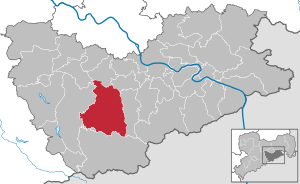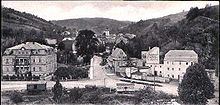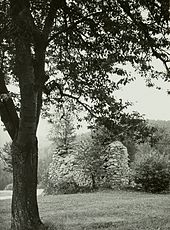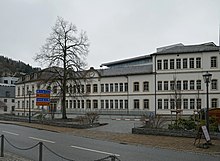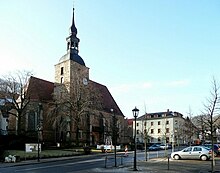Glashütte (Saxony)
| coat of arms | Germany map | |
|---|---|---|

|
Coordinates: 50 ° 51 ' N , 13 ° 47' E |
|
| Basic data | ||
| State : | Saxony | |
| County : | Saxon Switzerland-Eastern Ore Mountains | |
| Height : | 340 m above sea level NHN | |
| Area : | 95.64 km 2 | |
| Residents: | 6689 (Dec. 31, 2019) | |
| Population density : | 70 inhabitants per km 2 | |
| Postal code : | 01768 | |
| Area code : | 035053 | |
| License plate : | PIR, DW, FTL, SEB | |
| Community key : | 14 6 28 130 | |
| City structure: | 16 districts | |
City administration address : |
Hauptstrasse 42 01768 Glashütte |
|
| Website : | ||
| Mayor : | Markus Dreßler ( CDU ) | |
| Location of the town of Glashütte in the Saxon Switzerland-Eastern Ore Mountains district | ||
Glashütte is a small town in the district of Saxon Switzerland-Eastern Ore Mountains in Saxony and is known around the world in particular for the watch manufacturers located there .
geography
Geographical location
Glashütte is located in the eastern Ore Mountains in the Müglitz Valley . Since the merger with the municipality of Reinhardtsgrimma , Glashütte has extended into the neighboring Lockwitztal and is thus located in two main valleys of the Eastern Ore Mountains.
City structure
Glashütte is divided into the following districts (population figures as of May 9, 2011):
| Part of the community | Residents |
|---|---|
| Bear hedge | 49 |
| Brooch | 150 |
| Cunnersdorf | 498 |
| Dittersdorf | 456 |
| Glassworks | 1661 |
| House village | 377 |
| Hermsdorf am Wilisch | 134 |
| Hirschbach | 463 |
| Johnsbach | 426 |
| Luchau | 263 |
| Neudörfel | 56 |
| Niederfrauendorf | 198 |
| Oberfrauendorf | 374 |
| Reinhardtsgrimma | 762 |
| Back grove | 22nd |
| Schlottwitz (with Oberschlottwitz ) | 1119 |
In addition, the Hammergut Gleisberg is located in the area of the city.
Desolation
In the corridor of Glashütte are the three desert areas Greifenbach , Kleinhain and Zschörnichen . Greifenhain was located between Falkenhain , Johnsbach and Bärenstein , and was mentioned in 1791 with "Greifenbach, deserted construction sites which were used by the residents of Falkenhayn, Dittersbach, etc.". Kleinhain is in the same area as Greifenbach and could be identical to it. In 1731 the place was handed down as Haynigen and in 1733 as Kleinhayn . Zschörnichen is a desolate individual property with a former Vorwerk that belonged to Börnchen.
history
The origin of the place and its name probably go back to a glassworks , whereby the field name Glasberg, mentioned in 1493, no longer exists for the location. After the destruction by the Hussites in 1429, the place was described as a desolate village with two iron hammers in 1443 and first mentioned in 1445 as a glass hut . After the discovery of silver ore around 1490, Glashütte experienced a rapid economic boom. In 1506, the Saxon Duke Georg granted the town of Glashütte town rights . Glassworks was in the Altenberg office .
Mining
Even before silver ore was discovered, there were two hammers at Glashütte around 1429, which suggest iron ore mining. The later Glashütte mining area extended immediately north of the city to Cunnersdorf. There were isolated and relatively insignificant pits in the Brießnitz and Müglitztal valleys . The discovery of ore deposits can probably be dated to the year 1490, as the Bergordnung von Glashütte was promulgated in 1491 and 1493 . The first hut in the village is mentioned in 1502 and in 1506 Glashütte is raised to the status of a mountain town. However, the silver yields were rather low compared to other mining regions in the Eastern Ore Mountains. As a result, there were no investments in mining and Glashütte fell into the nimbus of a “poor mining town”. During the Thirty Years War , mining came to an almost complete standstill. Around 1650 and much later around 1787 there were significant attempts to revitalize the mining industry. The mountain buildings "Israel-", "St. Jacob "," Holy Spirit "," New Hope "," Help of God "," Apostle "and" St. Blasius-Stolln ”and the“ St. Christoph Fundgrube ”between Johnsbach and Bärenhecke. In 1875 mining at Glashütte was finally stopped for reasons of profitability. Mining official documents show a metal extraction of approx. 10 tons of silver and approx. 150 tons of copper from a total of 140 individual pits between 1525 and 1875.
Watch industry
Beginning
In 1845, Ferdinand Adolph Lange was the first master watchmaker from Saxony to settle in Glashütte. He followed a call by the royal Saxon government, from which he received 7,800 thalers start-up funding. Lange began training the first watchmakers. Despite considerable initial difficulties, the watch and precision engineering industry became the economic backbone of the city from around 1875. Well-known companies were:
- A. Lange
- J. Assmann German anchor watch factory Glashütte i. Sat
- Union Glashütte / Sa.
- Glashütter Präzisions-Uhren-Fabrik AG and Deutsche Präzisionsuhrenfabrik Glashütte eGmbH as forerunners of
- Uhren-Rohwerke-Fabrik AG Glashütte (UROFA) and its sister company Uhrenfabrik AG Glashütte (UFAG)
In addition to precision pocket watches, the observation watches and ship chronometers for the navy and air force from A. Lange & Söhne , as well as the aviator chronographs from the Tutima brand , whose manufacturer UFAG was based in the watchmaking town of Glashütte until the end of the Second World War and then in the VEB Glashütter Uhrenbetriebe (GUB) rose.
On the last day of World War II (May 8, 1945), Glashütte was bombed by Soviet planes and partially destroyed. After the end of the Second World War, the Glashütte watchmakers were expropriated by the Soviet occupying forces and from 1951 onwards, Glashütte watchmaking was consolidated into a VEB Glashütte watchmaking company (GUB) . The individual Glashütte watch brands disappeared from the market. The trademark rights remained with VEB GUB, but they were not used. Glashütte watches were now industrially produced in large series, but were still considered to be the more valuable timepieces due to their higher-quality construction, for example in comparison to the mass-produced goods from the Ruhla watch factory . Well-known mechanical automatic watch movements from VEB GUB were the “Spezimatic” (1960–1978), followed by the “Spezichron” (1978–1985); after that, the proportion of mechanical watch movements fell sharply and quartz watches were mainly built.
present
Well-known watch companies or brands that were re-established after 1990 using old brand names or that emerged from the former VEB Glashütte watch operations are:
- A. Lange & Söhne , one of the two most prestigious watch brands (to the Swiss Richemont luxury goods group, previously to VDO-Mannesmann), which exclusively manufactures mechanical wristwatches in the luxury segment
- Glashütte Original , the second of the two most prestigious watch brands, which also exclusively produces mechanical wristwatches in the luxury segment
- Union Glashütte / Sa. , developed from the VEB GUB by the entrepreneurs Heinz W. Pfeifer (meanwhile retired) and Alfred Wallner.
- Nautical instruments mill , ship chronometers and clocks, also with exclusively mechanical clocks
- Nomos Glashütte , also with exclusively mechanical watches since 1990
- the Bruno Söhnle watch workshop, with quartz watches and now also with mechanical watches
- Kronsegler, since 2004
- Hemess, since 2007, later CHWolf GmbH, ceased operations in March 2016
- Tutima since 2011, Glashütte branch of Tutima Uhrenfabrik GmbH, located near Bremen in Ganderkesee
- Moritz Grossmann GmbH since 2008
Another milestone is the establishment of the company Wempe Chronometerwerke from Hamburg, which operates the only test center according to the German chronometer standard in the former observatory in cooperation with the Thuringian and Saxon state offices for measurement and calibration and has also started its own watch production.
There are also a few small companies specializing in the manufacture of watch parts.
The German watchmaking school in Glashütte existed here from 1878–1951 , which was continued from 1951 to 1992 as an engineering school for precision engineering. The building has been the seat of the German Watch Museum Glashütte since 2008 .
additional
During the floods in 1927 and again during the floods in 2002 , when the Glashütte retention basin broke, the city suffered severe damage.
During the GDR era, the grave of the border soldier Peter Göring, who was killed at the border, in the cemetery in Glashütte was a place of solemn ceremonies. The city maintains and maintains this tomb after 1990.
Incorporations
- January 1, 1994: Johnsbach and Luchau
- July 1, 1995: Schlottwitz
- 1996: Dittersdorf
- January 2, 2008: Reinhardtsgrimma
Development of the population
Development of the population (from 1998: December 31) :
|
|
|
|
Data source 1551–1957: Zühlke 1966; 1990–2005: State Statistical Office Saxony
1 October 3
2 September 30
politics
City council
Since the municipal council election on May 26, 2019 , the 18 seats of the city council have been distributed among the individual groups as follows:
- CDU : 4 seats
- Reinhardtsgrimma voters' association: 3 seats
- Timeless: 3 seats
- LEFT : no seat
- Free voter community Johnsbach: 1 seat
- Alliance 90 / The Greens : 2 seats
- AfD : 4 seats
- Free community of voters Schlottwitz: 1 seat
Town twinning
Since 1990 there has been a partnership with the city of Schramberg in the Black Forest in Baden-Württemberg , which is based, among other things, on the commonality that both cities are very much shaped by the watch industry. The incorporated, formerly independent town of Reinhardtsgrimma has been working closely with the Chrzastowice (Chronstau) community in Poland since 1997 , and this is continued by the city as a whole even after the incorporation.
Culture and sights
Museums
Historical buildings
- St. Wolfgang Church
- Saxon post mile column from the market, reconstructed in 1981 with the original coat of arms from 1734, in front of the clock house on Altenberger Strasse (Müglitztalstrasse)
Economy and Infrastructure
History and overview
The economic structure of Glashütte was and is determined by the watch industry, other small and medium-sized companies, local handicrafts and service providers. In the 1920s, the city's economic development had reached a significant imbalance, so that finally a mountain of debt of 2.5 million marks had accumulated. The city administration had to file for bankruptcy, which was caused by massive urban manipulation.
After the Second World War , watch production in the well-known traditional companies could be resumed, even during the GDR era there was sustained demand for Glashütte quality watches , a large part of which could be exported.
In 2010, a total of 2,228 employees subject to social security contributions were recorded in the city and its districts, of which 1,202 were in the mining and manufacturing sector. The watch manufacturers and their associated suppliers continue to determine the structure. In 2011 the watch industry had a total of 1,160 employees. The two largest manufacturers are Lange Uhren GmbH , which had around 500 employees in 2010, and Glashütter Uhrenbetrieb GmbH with around 320 employees.
Established businesses
- Lange Uhren GmbH ( A. Lange & Söhne ), approx. 500 employees
- Glashütter Uhrenbetrieb GmbH ( Glashütte Original ), approx. 320 employees
- Roland Schwertner KG ( Nomos Glashütte ), approx. 140 employees
- Nautical instruments Mühle Glashütte GmbH , 47 employees
- Wempe Chronometerwerke , 39 employees
- Bruno Söhnle GmbH , approx. 20 employees
- Tutima Uhrenfabrik GmbH , 12 employees
- Union Uhrenfabrik GmbH
- Kronsegler GmbH
- PAKA Glashütte cardboard and cardboard factory
The number of employees in companies in the watch industry reflects the status in 2010
Former companies
- Müglitztal Brewery Glashütte existed from 1881 to 1981 and was demolished in 2008
traffic
Since 1890 Glashütte has been connected to the 38 km long Müglitztalbahn , which connects the clock town through the Müglitzal with Heidenau (Saxony) and the upper Elbe valley and the mountain town of Altenberg (Erzgebirge) in the upper Eastern Ore Mountains . On the single-track line, Glashütte acts as a crossing station between the trains traveling uphill and downhill. Buses operate in the city center.
Religions
The Protestant St. Wolfgang Church was built from 1521 to 1535, today it belongs to the parish Glashütte in the church district Freiberg of the Evangelical Lutheran regional church of Saxony . Further Protestant churches are located in the districts of Glashütte.
After Catholic expellees had settled in the glassworks, which had been evangelical since the Reformation , as a result of the Second World War, the St. Christophorus Church was built from 1952 to 1954. The church on Dittersdorfer Weg is named after St. Christopher and today belongs to the parish “St. Georg Heidenau-Zinnwald ”based in Heidenau , in the Dresden deanery of the Dresden-Meißen diocese .
The 2011 census in the European Union showed that around 27% of the 7,008 inhabitants of the city of Glashütte belonged to the Protestant Church and around 4% to the Roman Catholic Church. The majority of the inhabitants did not belong to any religious community.
Personalities
- Ferdinand Adolph Lange (born February 18, 1815 in Dresden ; † December 3, 1875 in Glashütte), watch manufacturer, Member of the State Parliament, mayor of Glashütte
- Conrad Brüne (born October 19, 1853 in Glashütte; † July 22, 1931 in Radeberg ), master brewer, brewery director ( Radeberger Pilsner )
- Arthur Burkhardt (born January 24, 1857 in Apolda , † July 21, 1918 in Glashütte), engineer and manufacturer, founder of the German calculating machine industry
- Gerhard Schiffel (born March 22, 1913 in Glashütte; † August 12, 2002 in Heidenau), graphic artist, draftsman and painter
- Heinz GO Becker (born March 4, 1922 in Dittersdorf; † July 23, 2017), chemist and university professor
- Hans-Peter Kaul (born July 25, 1943 in Glashütte; † July 21, 2014), judge, international lawyer and diplomat
literature
- Karlheinz Blaschke : The historical development in the Eastern Ore Mountains. In: Eastern Ore Mountains (= values of the German homeland . Volume 10). 1st edition. Akademie Verlag, Berlin 1966, pp. 187–193.
- Karlheinz Blaschke: The urban system from the 12th to the 19th century . Supplement to map B II 6 of the Atlas for the History and Regional Studies of Saxony (published by the Saxon Academy of Sciences and the State Surveying Office of Saxony). Leipzig / Dresden 2003.
- Erich Fritzsch, Lothar Kempe: Eastern Ore Mountains. Brockhaus, Leipzig 1981.
- Martin Hammermüller: Lauenstein - Bärenstein - Glashütte. Our little traveling booklet 40.Bibliographisches Institut, Leipzig 1961.
- Gerhardt Müller: Between Müglitz and Weißeritz (= values of the German homeland . Volume 8). 1st edition. Akademie Verlag, Berlin 1964.
- Otto Eduard Schmidt : On the settlement history of the river areas of the Müglitz and the Gottleuba. In: Communications of the State Association of Saxon Homeland Security Issue 9-12 / 1927. Dresden, pp. 367-378
- Rudolf Schumann : Manuscripts of the mining history of the Osterzgebirge. (Ed. by the Knappenverein Altenberg e.V.). Kleinvoigtsberg 2003
- City administration Glashütte (ed.): Glashütte - Saxony - 1506 to 2006 - 500 years of city history. Glashütte 2006, ISBN 3-937951-31-8
- Urban settlements in the eastern Ore Mountains. In: Eastern Ore Mountains (= values of the German homeland . Volume 10). 1st edition. Akademie Verlag, Berlin 1966, pp. 244-257.
- Richard Steche : Glassworks. In: Descriptive representation of the older architectural and art monuments of the Kingdom of Saxony. 2. Issue: Amtshauptmannschaft Dippoldiswalde . CC Meinhold, Dresden 1883, p. 34.
Web links
- Publications on the city of Glashütte in the catalog of the German National Library
- Search for Stadt Glashütte in the archive portal-D of the German Digital Library
- Glashütte in the Digital Historical Directory of Saxony
- City of Glashütte / Sa. - official homepage of the city administration Glashütte
- Glashütte - private homepage about Glashütte by Daniel Schütze
- Glashütte watches - Glashütte watch industry: history, models & calibers
- Portrait feature of Glashütte, 30min., To listen to at MDR Kultur
Individual evidence
- ↑ Population of the Free State of Saxony by municipalities on December 31, 2019 ( help on this ).
- ↑ State Statistical Office of Saxony: 2011 census, population, households, families and their housing situation on May 9, 2011. State Statistical Office of the Free State of Saxony, September 1, 2014, accessed on May 27, 2019 .
- ↑ Greifenbach in the Digital Historical Directory of Saxony
- ↑ Kleinhain in the Digital Historical Directory of Saxony
- ↑ Zschörnichen in digital Historical Gazetteer of Saxony
- ↑ Hiking guide 'Around Dresden Süd - between Bad Gottleuba and Meißen' Heimatbuchverlag Michael Bellmann 2009; ISBN 978-3-937537-07-8 , page 101
- ↑ Thomas Baumann-Hartwig: Insolvency: watch manufacturer in Glashütte has to give up . In: Dresdner Latest News , March 1, 2016.
- ↑ StBA: Changes in the municipalities in Germany, see 1994
- ↑ StBA: Changes in the municipalities of Germany, see 1995
- ↑ StBA Area: changes from 01.01. until December 31, 2008
- ↑ State Statistical Office of the Free State of Saxony: Results of the 2019 municipal council elections in Glashütte , accessed on April 16, 2020
- ^ SOS call of the city of Glashütte . In: Vossische Zeitung , April 6, 1929, p. 7.
- ↑ State Statistical Office Saxony - Municipal statistics Glashütte / Sachs. 2011 reference.
- ↑ Glashütte watches create jobs , Sächsische Zeitung (Dippoldiswalde edition) of January 4, 2011
- ↑ A watch tradition is revived
- ↑ a b These watch companies open in Glashütte, Sächsische Zeitung from July 14, 2010.
- ^ Church on the parish website
- ^ Church on the parish website

